
SFBI baguette weekend workshop - a photo report
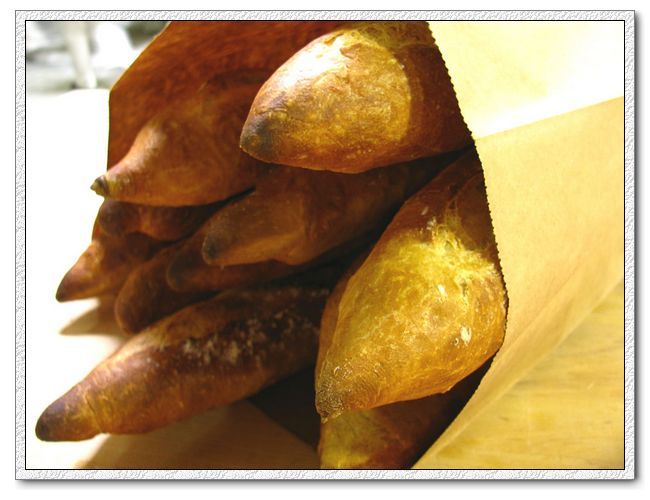
I have wanted to take classes from SFBI for so long, but TX is not exactly close to SF, and my day job really gets in the way of scheduling. When I saw they started offering some weekend workshops, I jumped on the opportunity. And of course, I picked the baguette class, since that's my main obsession.
Arriving early to be greeted by friendly classmates, teacher, and lots of fresh croissants. While we were going through our class, the students were just producing breads nonstop the entire time, and lucky us got to sample a few.
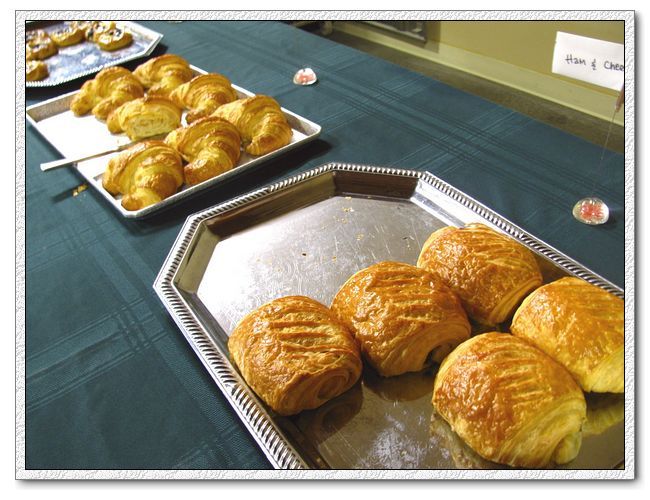
Hmmm, I wonder if I can ask for this to be my birthday gift? I am sure we can fit one in.... if we tear down our living room and den!
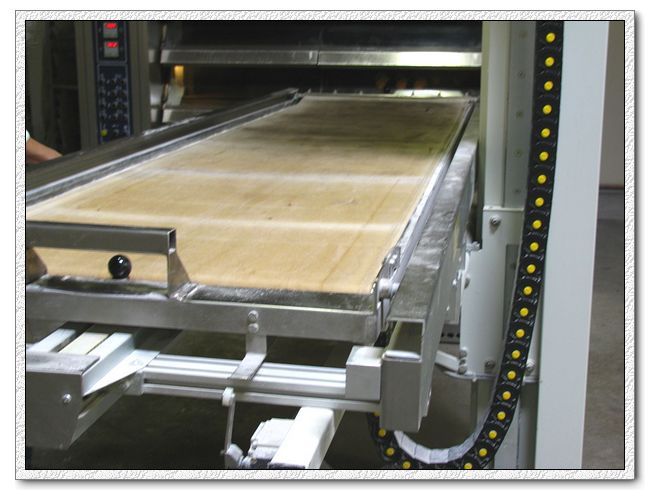
Would anyone notice if I just take a couple?....I AM KIDDING!
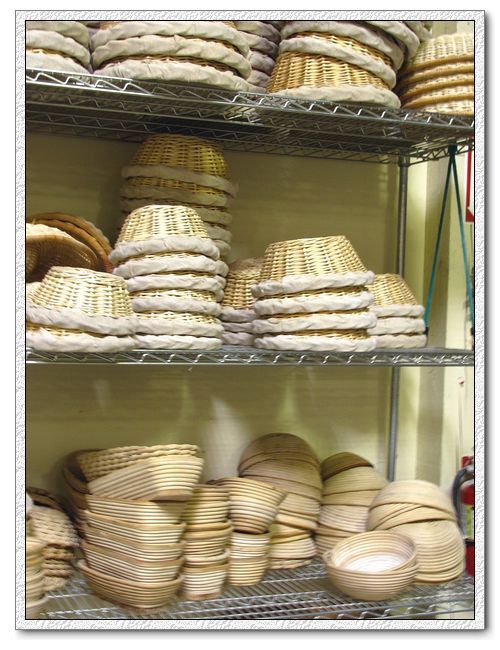
Now, let's get to work, 3 types for the first day: straight dough, poolish, and sponge. All done with minimal mixing (hand mixed to incorporate), and 3 sets of S&F.

I have done S&F every weekend, but handling 7.5KG of dough is decidely different from handling 1KG. Note to self, must lift weights.
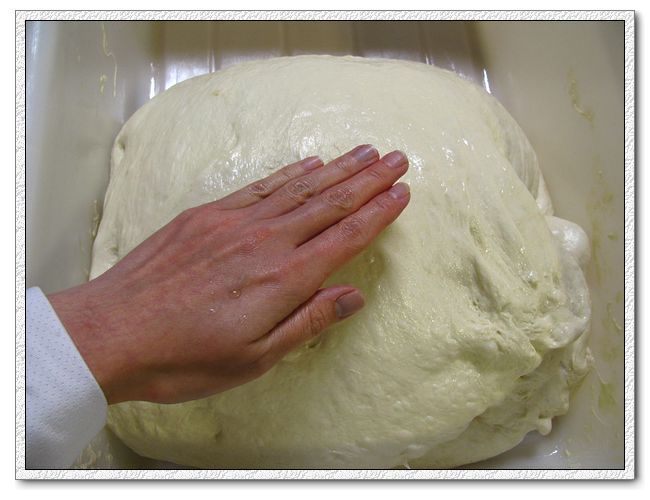
We had lectures while waiting for the dough, but my favorite part is the hands on part. Look at the big tubs of dough, this is when I realized that professional baking is a very very very physical job. Oh, I also would like a kitchen that's as big as this!
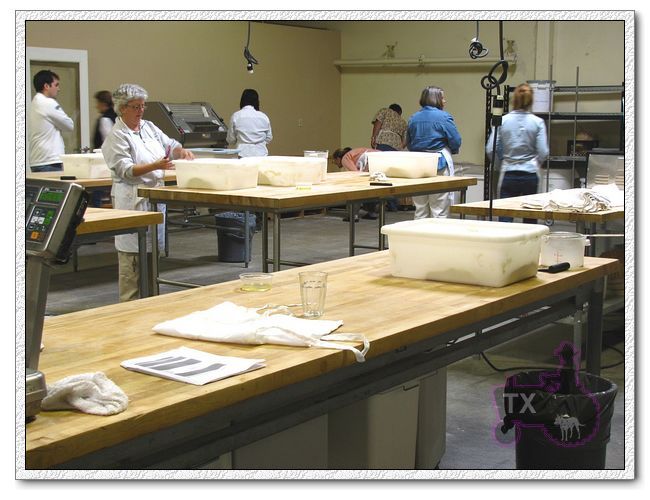
Teacher Frank is showing us how to divide and preshape. Even pieces, even tension, repeat.

We make 5 pieces for each type of baguette, my preshaping is far from perfect

Many many many trays of dough - 15 pieces per person per day

It's almost 2pm, we are starving. Let's get these babies shaped already! My batch of straight dough baguettes here - with my name on it!
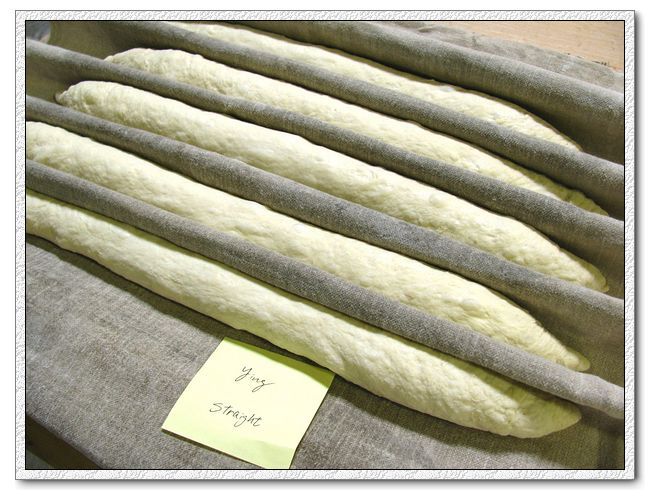
Lunch , thank goodness. We inhaled that one. On 2nd day, we had pizza (yum!) and wine for lunch. Let's just say there were a lot more giggling in the afternoon session.

Well fed, let's check on the dough, ready to be scored and baked!
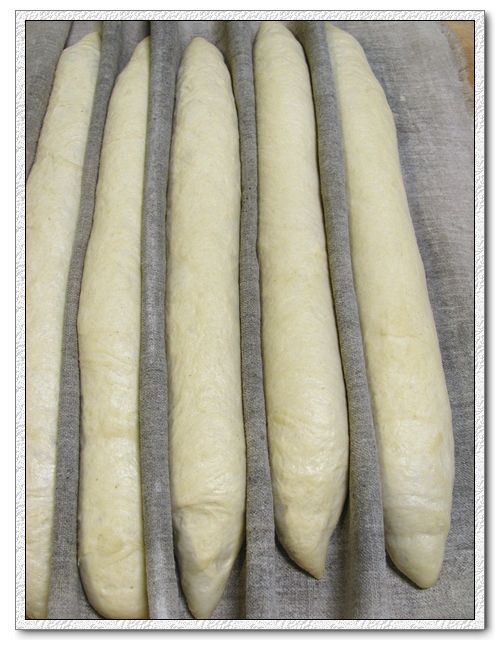
Loading is "interesting". Frank also showed us the home oven method (baking stone, cast iron skillets underneads to create steam etc.).
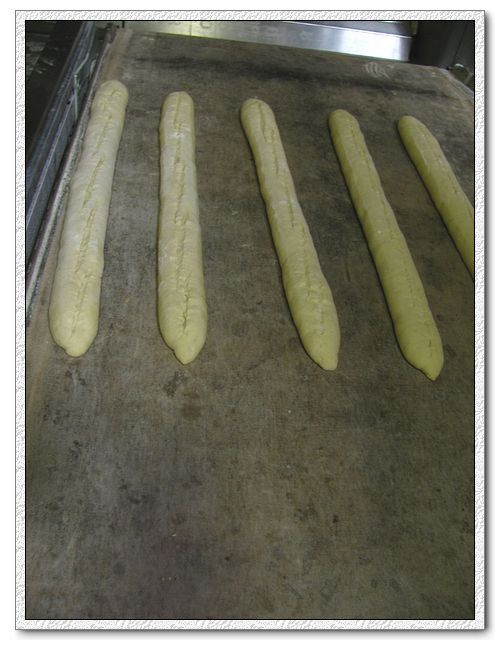
Best part, time to taste and critique! These are Frank's, hole-y and beautiful
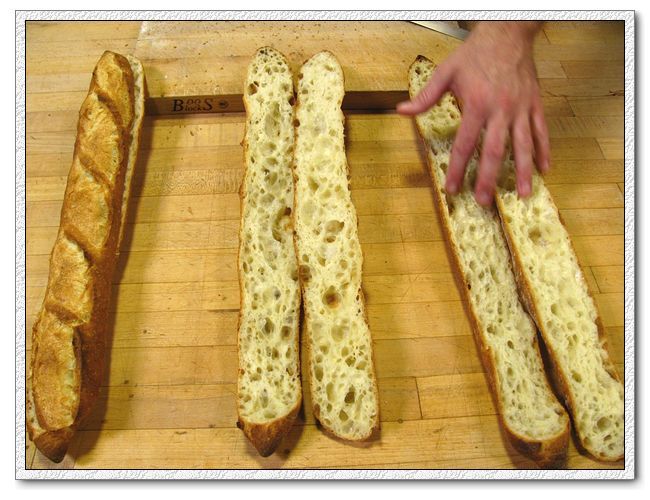
These are mine. The dough is about 68% hydration, not so wet, so scoring was not difficult, I am semi-happy with the left two, no idea what happened for the one on the right. Seems that I loaded it too close to the right edge, didn't get browned on that side. It's straight dough, poolish, and sponge from left to right.
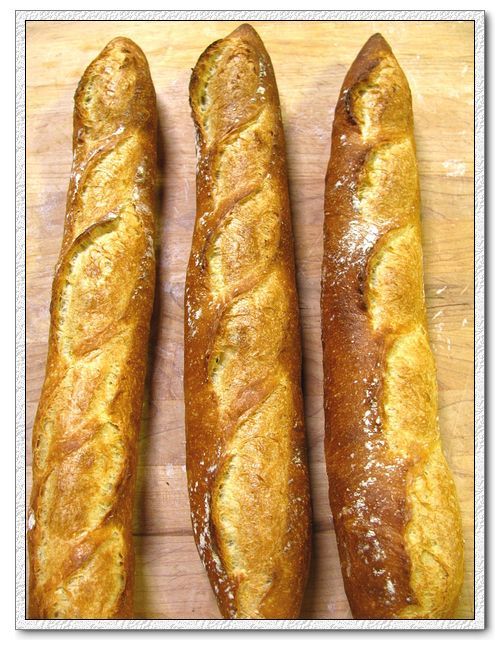
Not as open as Frank's crumb, need more practice with the new shaping method.
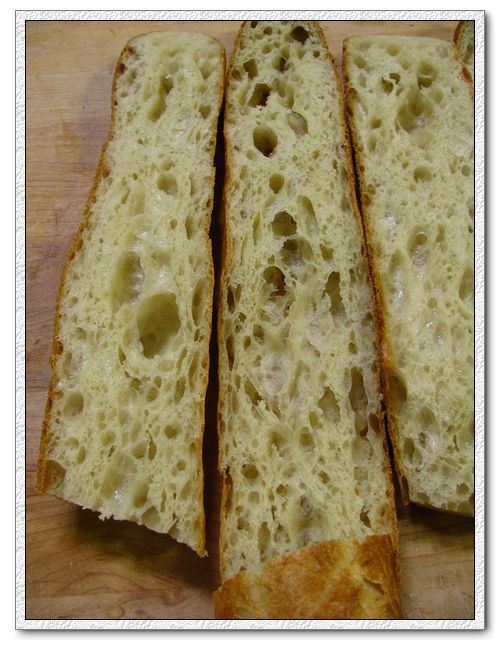
We all like the taset of sponge one the best, but all three are delicious.
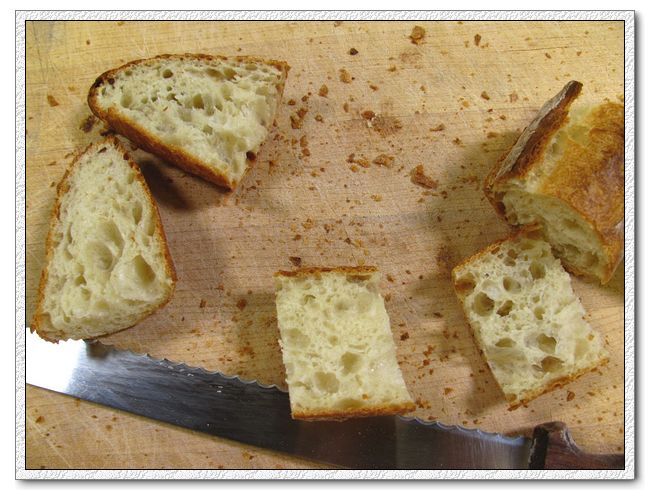
We did 3 more formulas on the 2nd day (With teff, with sunflower seeds, and ww with wheat germ), and tried epi too.
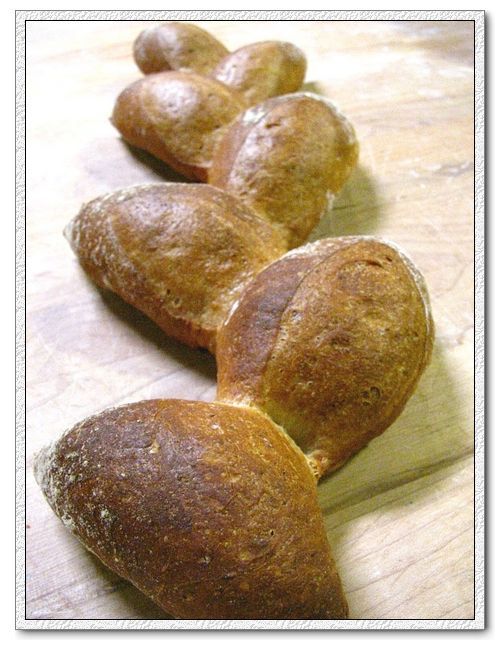
All in all, a great experience! A lot of the info were familiar to me thanks to the knowledgable people here at TFL, but it helps tremendously to see close up how a professional handles the dough , and practice on 15 baguettes each day. Frank was very helpful answering questions and helping too. The shaping and preshaping methods are slightly different from what I have been doing previously, I like this new way better, will keep practicing at home for sure. Everyone ended up with loads of bread at the end of each day, since I was from out of town, I gave most of mine away to a classmate, who then distributed to elders in her neighbourhood - makes me happy.



Comments
Thank you so much for sharing your experience!
I can hardly wait for my Artisan I class at SFBI in August! I better forewarn my SF and Oakland relatives to expect bread bombardments that week!
David
And learn so much, I am seriously jealous. It's a good idea to clear out freezer space, find enough friends and relatives, AND locate a food bank for all your breads. I heard that in the longer classes, they start out slow, but after ramping up, you'd bake 5 different types of bread per day! I am guessing 20 loaves at the end of the day?
your photos and write-up, txfarmer! I really enjoyed reading about your experience and looking at your photos.
Sylvia
It was so much fun, perfect for a bread geeks like us. ;)
Thanks for letting us tag along. I see that your quest for the ultimate baguette is moving along very well...
Don
That probably will be forever out of reach for me, but the fun is in the journey right? :P
Drooling..
Txfarmer, enough isnt enough for you!
I love your ambition. Nice writeup and pics, and very attractive breads!
Khalid
I am indeed a bit obsessed huh? :P
Absolutely fabulous. An appetizing tour de force. Great pictures and great breads. So the airlines wouldn't let you smuggle a loaf aboard as a memento? You have the rest of us green with envy. But thanks for the post. Just a question, though; You used three different methods (straight dough, poolish and sponge), but it appears as though they were all on the same time schedule, rather than using any delayed or cold or low yeast initial rise methods usually associated with poolish and sponge methods. Or did I misunderstand something. I would appreciate any comments. Thanks again.
Those were made the night before。 For the first day, they were made for us by staff previous evening, for the 2nd day, we made them ourselves at the end of first day. After mixing, the schedule was indeed the same for all breads.
Everything about the class seems great.
I'm just curious about the pre-shaping and shaping techniques that they tought. You say they're a little different than what you're used to-can you elaborate?
Thanks.
My old way is very adhoc, basically what I see from youtube and books:
1)preshape into batard
2)shaping: pat into square, fold top to middle, fold bottom edge to middle, fold in half, seal, roll into long baguette. Taking care to keep surface tension tight, without destroying bubbles inside.
Their way:
1)preshape into cyclinder, which I like better than batard, makes more sense for baguette
2)shaping:pat into square, roll top edge twice, fold the bottom edge up into middle, fold in half, seal, roll into long baguette. Taking care to keep surface tension without destroying bubbles inside. As you can see, the shaping method is not that different from mine, the principles are the same, just different execution. I think their way is easier and faster once become familiar.
I posted in another post about wanting to treat myself to a bread-making holiday when I retire in a year or so but looking at your pictures now, I'm totally intimidated but all of this. Its a worthwhile experience but as you commented, kneading a 7.5 kilo dough is very different from a 1 kg. dough. I'm normally handling 500 grm max. Having second thoughts as I type. This is really more suited to someone who wants to become a serious baker or take it up as a career, and not for someone like me who's just wants to learn the basics. Moreover, I would have to travel all the way from the far east for this......This post has been a great help to me.
Actually just the opposite, I think this class is perfect for beginners, and mainly aim at home bakers. Yes, we do handle a lot of dough, and use professional ovens, but the instructor covered how to adapt the operation to home oven - even did demo on that. More importantly, the formulas used in the class are perfect for beginners - mix just to incorporate, S&F 3 times in a long 3 hour fermentation, takes the guess work out of "how much to knead". The hydration of the dough is from 68% to 70%, easy to handle and score. I especially found it helpful to see the instructor demonstrate: divding, pre-shaping, shaping, and scoring, makes so much more sense to see a professional doing it up close. Plus the experience you get for practicing these moves on a lot of dough in a short period of time is invaluable.
Basic theories on all stages of bread making were covered in the lectures. Most people in the class are beginners, at least not familiar with artisan bread making. All of us are home bakers with zero intention to "go pro", I would highly recommend it to anyone who wants to learn to make baguettes at home.
Thanks tsfarmer for the info. The more I ready your comments, them more I'm tempted to enrol in one of their classes. I've benn thinking about it almost everyday and i just need to make the first step and renew my US visa. My one other concern is whether I can physically cope with the intensive workload being a fairly small asian at 5' 3" weighing in at 110 lbs. Do you use machines for all the kneading work? Thanks in advance for whatever advice you can give. Judy
All hand knead, but like I said, there's NO heavy kneading, just mix to incorporate and S&F.
I am Asian, 120lb, so I really don't think workload would be an issue. Yes, it would be tiring but totally managable.
Oh wow. thanks for all those great pics and the write up. I kind of envy you for that to be honest:)
Ha, they have a lot more classes coming up, maybe you can take one yourself!
A great read and (as always) lovely photos!
Thanks!
I'm totally motivated to see if I can detour to SF in my next trip. What wonderful experience, and beautiful baguettes!
I'm just wondering what the difference in taste for the 3 baguettes?
Straight dough: the simplest, with the long fermentation and minimal kneading, you do taste the rich flavor in the flour, but not too much complexity
poolish: a bit more complex, sweetness at the back of your tongue
sponge: our favorite one. most complex, slightly nutty after taste, sweeter than the previous two
Oh, I got this feed on my email but could not stop by to read it....
WONDERFUL POST, Txfarmer! You definitely deserve to be in a class like that, already being the amazing bread baker you are!
One day I might learn how to shape a baguette, until then, I 'll have to be happy with my ugly examples, but at least the taste is ok... :-)
(by the way, your Chinese text on croissants was studied by me and my tutor yesterday, I finally got to know what Richard Gere had to do with it! We both loved your story!)
Wasn't he just so dreamy? In "Pretty Women" era? :P Now everyone is going to wonder what do RG, baguettes, croissants, and I have in common.
Thanks, TXfarmer! What a great bunch of photos and explanations! I mainly bake sourdough, but this inspires me to do some baguettes. I wonder what exactly is meant by "sponge." How long does the sponge develop? (I assume putting the yeast into water w/ flour and perhaps some sugar and letting it bubble up, but I could be wrong.) Did the instructors talk at all about using fresh yeast? I have used it in challah, and it makes a difference (more "yeasty" flavor, richer too. (I also baked a sourdough challah, believe it or not, from Maggie Glezer's recipe--very good, very interesting, not at all what we've come to expect a challah to taste like.)
Thanks again! I'm putting baguettes on my "to do list"!
Joyful
Sponge means a firm preferment here, mixed and rise over night just like poolish, the only difference is the hydration.
The class didn't use fresh yeast. I have personally used it, while it is "different", I cant say it's better or worse than DIY, just "different" to me. I mostly bake with sourdough too, that's my preferred fermentation method, mainly a personal taste I guess. I have made that sourdough challah too (and blogged about it here: http://www.thefreshloaf.com/node/17725/sourdough-challah-shape-hungarian-celebration-loaf), yes, it was great! In fact I am using sourdough for a lot of Asian soft lightly enriched breads, as well as European style lean breads, I like the tangy taste it brings to the table.
Hi txfarmer - I've been so wrapped up in a new job I haven't had time to read or respond to posts, but when I saw the title of yours...well, I had to stop and smell the roses.
It sounds like a wonderful experience! - and brings back my memories of baguettes at King Arthur Flour. You gain so much insight with a good teacher and a production environment where you're actually turning out a lot of dough!
I think your shaping, scoring and crumb are absolutely wonderful! Everything from here on in will be tweaking.
Thanks for sharing via photos your adventure!
Larry
Thanks Larry! I have a feeling the "tweaking" will be never-ending, which is part of the fun. :)
Excellent photos of your tour! I love your side by side comparisons. Thanks for sharing.
Eric
THanks Eric! It was interesting trying to get the good shots when I am elbow deep in flour and dough! :P
Beautiful shots and love the angles! Thanks for sharing your fun!
Mini
Thanks Mini!
Back again, TXfarmer!
You said the sponge was like a poolish except for the ratio between flour and water. I looked in JH's BREAD for a definiteion of "sponge" but didn't find that. Did you mean a lower or higher hydration for a sponge. Is it like a biga? Specifics would be helpful for my baguette plans.
BTW, my husband and I felt like the sourdough challah from A BLESSING was a different sort of "animal." It was an interesting bread, but not really a challah (OK, I know Maggie says it's the way they made it in the "old days"). I think the shaped loaves may have overrisen just a tad, so the braids in the finished loaves were a bit ill-defined (I baked the breads in loaf pans). Don't know if I'll do that one again.
As for sourdough, I just made the sourdough "semolina" bread in JH's BREAD, with lots of sesame seeds on the outside (sprayed the tops of the shaped loaves and then dunked the tops in a tray of sesame seeds; no seeds in the dough). It was one of the most delicious breads EVER! (I got durum flour from KA.) Try it if you haven't already!
Joyful
I think there's a different definition for SFBI sponge VS. sponge in other books such as "Bread". In our class, sponge is just a firm starter with dry yeast (I have to go home to look up the exact value). For SFBI sponge, it's indeed made by mixing water and flour (around 60% water) with yeast, rise overnight, then use. Just like a firm sourdough starter tastes different from a liquid one, SFBI sponge tatses different from SFBI poolish. It's swweter. I do think it's similar as "preferment" in "Bread".
The sourdough challah tastes great to us, the extra tang is what we loved about it, just like the sourdough pandoro I made a few months back. Yes, I've made the sourdough semolina bread, you can find my post here: http://www.thefreshloaf.com/node/18426/pain-au-levainsemolina-sourdough-quotbreadquot-and-some-semolina-pasta - a great bread indeed
Joyfulbaker,
As I understand the terms, when making a sponge, you use ALL the water in the total formula (recipe) and only part of the flour. The next day, after the preferment, you add the additional flour and other dry ingredients. When you look at the math, a sponge has a high hydration level, which is later lowered when the rest of the flour is added to make the final dough. In a poolish, similar to a biga, you use part of the flour and part of the water, and add the rest of the flour and water the next day to make the final dough. Depending on the ratios, the hydration level of the poolish or biga may higher than or equal to (but usually not less than), the hydration level of the final dough. So a poolish will have a lower hydration level than a sponge. Does this make sense?
If my understanding is amiss, I hope others will comment. Thanks. Bob
Thank you, Bob. Your explanation is very clear. It seems sensible: The final dough won't be "watered down" in that all the water in the dough will have had the time to take on the flavor of the preferment. The final hydration with a sponge may in fact be the same or almost the same as a dough with a poolish or biga, but the difference would be in the flavor. Now I wonder how long the sponge should be allowed to develop. (I've heard 6 or 7 hours, sometimes overnight--I guess ambient temperature plays a role.)
Now, just to bake the baguettes! (I'm a scaredy-cat, so I'm going to check out several recipes for "sweet" baguettes--feel I need to as I almost always bake sourdough!)
Again, thanks. Isn't TFL wonderful! We can all talk to each other; it's SO helpful.
Joyful
Joyful - you may want to try JH's baguette with Pate Fermentee. Tried it, and love the taste of it, it has a certain sweetness that I couldn't find in other recipes. I just baked it yesterday, not as good looking as those in the pictures here as I'm still learning how to shape baguettes well. Did a slight change on the recipe. See my post here.
Thank you!
Betty